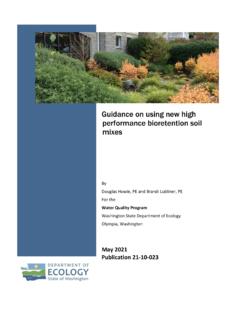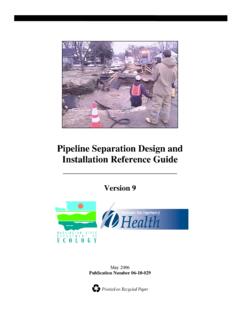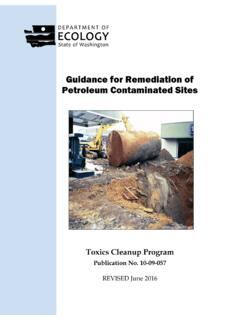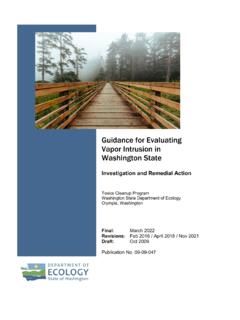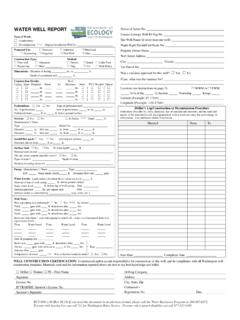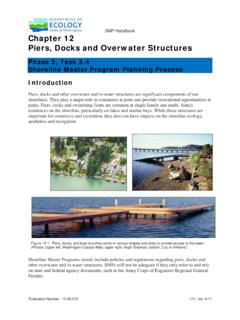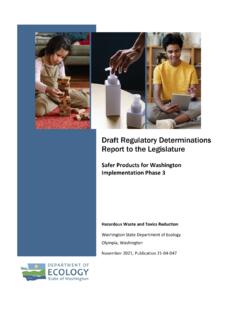Transcription of Homeowners’ Guide to Wetlands pursue a permit& Buffers
1 Publication Number: 14-06-022 1 May 2014, Revised April 2018 Homeowners Guide to Wetlands & Buffers Adapted from At Home with Wetlands A Landowner s Guide (Publication #90-31) Wetlands are important features of our natural landscape and offer significant economic benefits. If a community had to replace the flood control or water treatment functions provided by Wetlands , the human-engineered expenses could cost far more than preserving our natural wetland systems. Many people don t realize healthy Wetlands are among the most productive ecosystems on the planet, comparable to rainforests and coral reefs. Wetlands are part of a diverse, complex set of ecosystems vital to Washington s economy and an important part of our natural heritage.
2 General protection As a homeowner, you play a big role in wetland protection and health. Protecting a wetland doesn t necessarily require additional effort. Often times it is what you don t do that is important. Your most effective protection strategy could be as simple as safeguarding it from future damage. This means maintaining a buffer (protective zone) around the wetland and protecting the water and plants within it. Regulations Wetlands are protected by local, state, and federal laws. Certain activities are restricted in Wetlands such as filling, grading, ditching, and draining. Homeowners generally need permits from local, state, and/or federal agencies to engage in these activities. The permitting process can be expensive and often involves some form of compensatory mitigation to offset the loss of wetland functions in the area affected by the activity.
3 If you wish to pursue a permit or find out what activities and uses are allowed in your area, start with your county or city planning department. You can also refer to the local critical areas code. If your property is on a shoreline, refer to the local shoreline master program for allowed uses and modifications. If there is a wetland mitigation site on your property, it is likely that the Washington Department of Ecology or Army Corps of Engineers issued a permit for the property. You should refer to the permits for specific conditions that apply to the wetland mitigation site. If you have questions, find the Department of Ecology wetland contacts for your county at: Septic systems Septic systems are one pollutant source for Wetlands .
4 Be sure your septic system is operating properly. If you notice the area over your drainfield is particularly green or you can smell sewage during rainy periods, then your system is not working properly. Seeping septage may be polluting nearby areas, including your wetland. To avoid this problem, have your septic system regularly pumped and inspected usually every three to five years. Clearing and mowing Sometimes homeowners mistakenly clear brush, mow grass, or both within the buffer area and sometimes directly in Wetlands . These activities adversely affect the soil structure, the type of plants that grow in the area, and the density and overall health of the vegetation. These changes can affect Wetlands filtering, flood control and water recharge capabilities and damage wildlife habitat .
5 Publication Number: 14-06-022 2 May 2014, Revised April 2018 Many wildlife species need a complete noise and visual barrier from human activities. Even clearing a small swath through the buffer to allow better visibility or access to the wetland creates problems, especially if the wetland is located near homes or development. Imagine living near a busy street with only a thick hedge protecting you from the noise and disruption. Removing just a small portion of the hedge would increase the noise you hear and decrease your privacy. Using chemicals Fertilizers, herbicides, and insecticides represent a potential threat to your wetland. If these chemicals are used on adjacent or upstream lawns or farmland, it is likely they will eventually enter local waterways and Wetlands .
6 These chemicals alter the ecological balance of Wetlands and can indirectly create many problems. For example, certain pesticides will eliminate important insects and other invertebrates that work in the wetland. While you might not notice these pests are gone, you may see an algae bloom taking over the pond because the insects and microscopic life that may normally have controlled the algae are no longer there. A lack of insects may also mean fewer songbirds because their food source is gone. Likewise, additional nutrients from fertilizers will cause extensive plant growth. As these plants eventually decay, they will use up oxygen that is necessary for aquatic life, resulting in a stagnant, smelly wetland. To find safe alternatives to using fertilizers and pesticides, contact your county WSU Extension Office or visit If you use fertilizers or pesticides, always follow the manufacturers directions carefully.
7 Do not apply more than is recommended and use these chemicals during periods of dry weather when you can be assured they will not wash away with the next rainfall. The best way you can protect your wetland is to establish a chemical-free zone surrounding your entire wetland and any streams, lakes, or other surface water. This zone should include a densely vegetated buffer strip, 50-75 feet wide, to provide extra filtering capacity to prevent chemicals from reaching your wetland. Dumping and filling Unfortunately, Wetlands have traditionally been viewed as wasted land and often used as garbage dumps. Plastics, paper, cardboard, wood, glass and aluminum refuse can all be found in our Wetlands . This garbage should be removed and neighbors and other likely dumpers educated about the important functions and wildlife areas Wetlands provide.
8 A great way to educate people is to invite them to help remove the garbage as a neighborhood cleanup project. Sometimes people throw lawn clippings, fill dirt, wood chips, and other yard waste into Wetlands . This is often done with the intent of filling the wetland, perhaps to extend a lawn or garden area. Any type of filling means decreasing a wetland s capacity to control flooding in your area and can degrade water quality. Dumping yard waste can also cause changes in a wetland s chemical balance. While yard waste is made up of natural materials that will eventually decompose, they can damage a wetland in the process. As they decompose they release nutrients, cause oxygen depletion, and again result in a stinky, stagnant wetland. The best thing to do with yard waste is to compost it.
9 Make sure to locate any compost piles at least 100 feet from your wetland or other surface water to ensure the nutrient-laden runoff water will not reach them. Pet control Unrestrained dogs and cats pose a threat to wetland wildlife by destroying nests or preying upon adults and their young. The best way to Publication Number: 14-06-022 3 May 2014, Revised April 2018 protect wildlife is to keep your pets out of the wetland entirely. However, dogs also can be restricted from the wetland during early spring and summer and requiring leashes throughout the year is a less limiting measure. This gives them access to the wetland yet eliminates wildlife disruption. Cats can be highly efficient predators and in some areas their sheer numbers hurt wildlife , especially songbirds.
10 You can place bells on the collars of your cats. You also can keep your cats indoors during early morning and dusk when wildlife is most active. Recreation overuse Off road vehicles (ORVs) motorcycles, all-terrain vehicles, and mountain bikes destroy soils, vegetation, and wildlife habitat within your wetland and its protective buffer strip. Motorboats disrupt wildlife and Wetlands located along the shores of rivers, lakes, and estuaries. Boat wakes can cause severe shore erosion in heavy recreational use areas. Passive recreational activities such as hiking, canoeing, and bird watching are compatible with wetland protection as long as wildlife and their habitat are not disturbed. Not disturbing them may require closing the wetland to all or certain uses during breeding or nesting seasons.
